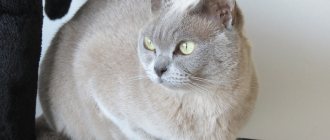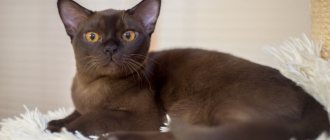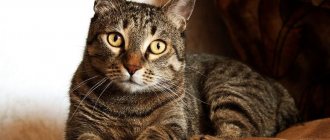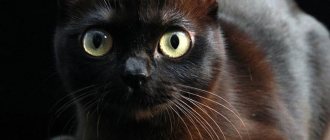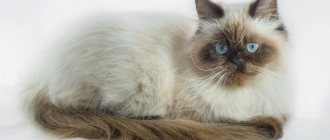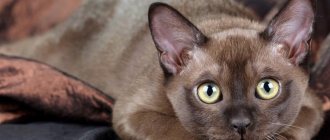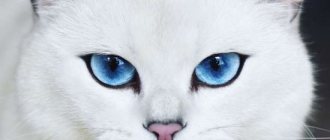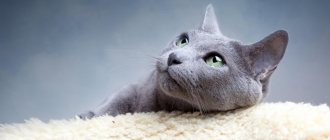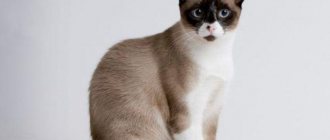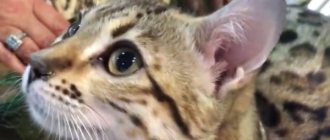Pets make our lives more interesting and fun, and also teach us responsibility. Some of the animals have been with people for many years, for example, cats. These graceful and graceful creatures can leave few people indifferent. Any home where a cat lives becomes a little more comfortable. Thanks to the almost countless number of cat breeds, everyone can choose a pet to suit their taste. For those who prefer cats with a more classic appearance and solid color, the Burmese breed is suitable.
Description of the Burmese cat breed
The description of the above breed includes several characteristics and qualities that the animal must fully comply with.
Dimensions and weight of the Burmese cat
When you look at a Burmese cat, you get the impression that it is a very light, almost weightless, medium-sized animal. But as soon as you take her in your arms, you immediately understand your mistake. So, an adult cat of this breed can weigh about 9 kilograms, and a female cat can weigh about 6 kilograms. It’s not for nothing that the popular phrase “a brick wrapped in silk” is used to describe the Burmese breed.
If we consider the weight of the Burmese by month, we get the following picture:
| Age | Male | Female |
| 1 month | From 450 to 750 grams | From 300 to 500 grams |
| 3 months | From 1.5 to 2.4 kg | From 1.2 to 1.7 kg |
| 6 months | From 3 to 5.7 kg | From 2.5 to 3.6 kg |
| 1 year | From 6 to 7.5 kg | From 3.5 to 5.4 kg |
| 2 years | From 8 to 9 kg | From 4 to 6 kg |
Advice for future owners
The described disadvantages and advantages cannot be perceived unambiguously. It all depends on the needs of the future owner. If the decision to own a Burmese has already been made, several recommendations will be useful to owners:
- If the absence of owners in the house is inevitable, you can get a second cat , which will become a companion for the Burmese.
- If a cat of this breed is not acquired for breeding, it is worth sterilizing . Your veterinarian will advise you about the appropriate age for this operation.
- You need to be prepared for hooligan antics . Prepare the apartment by removing valuable and fragile items.
- Despite the excellent health of the Burmese, we must not forget about vaccinations, regular visits to the veterinarian and proper nutrition.
For some, the Burmese's sociability will be a disadvantage of the breed. If a family wants to get a cat to decorate the sofa, then this beauty is definitely not suitable
Knowing about the characteristics of the Burmese beauty, all that remains is to understand your desires and capabilities. If the future owner is ready to share his attention and time with the cat, then the Burmese breed will come in handy. You need to understand that this smart girl will fight for the right to become a member of the family. And be sure to think carefully about whether you want to expand your family in this way.
Burmese standard
- Build: Muscular, strong, incredibly well-built, medium size. Males are always larger and heavier than females. The chest is quite powerful, which gives the impression of the strength of the Burmese cat. The back is equal.
- Coat: thick, short, without undercoat, very soft and pleasant to the touch, dense.
- Head: rounded, muzzle short with an elongated forehead, wide cheekbones.
- Neck: strong, thin and long.
- Eyes: large, very expressive, round in shape. They shimmer in all shades of yellow (from honey to amber) and green. Moreover, the older the Burmese cat is, the lighter the color of its eyes becomes.
- Ears: beautiful triangular shape, slightly rounded tips.
- Limbs: ideally proportional to the body, medium size. The paws are neat with fairly developed muscles. This cat breed has five toes on the forelimbs and four on the hind limbs.
- Tail: Medium length, slightly tapering towards the tip.
Colors of Burmese cats
The color of Burmese cats also has its own characteristics. Thus, the European type of this breed is allowed to have almost any color without stripes or spots. But the American type is allowed to have only four colors:
- Sable. It is a rich chocolate shade that becomes darker on the face, paws and tail.
- Blue. This color can be either uniform or slightly darkened on the tail and muzzle.
- Champagne. Its color is a little reminiscent of coffee with milk, but it becomes darker on the paws, nose, tail, and ears.
- Platinum. It is also called lilac. It's a beautiful shade of creamy color that deepens on the face.
Color options
The specific genotype affects the combination of colors, so the hair is slightly lightened . So the black color turns into brown according to the will of nature. Basically, the top of the body is always dark, and the bottom is lightened, this is another feature of them.
There are several types of colors:
- Sable is the most popular, you will recognize it immediately. The body is painted in one chocolate tone - milky or dark in saturation. The nose and pads are the same.
- Chocolate - very similar to the previous one, but differs from it in the presence of a characteristic mask on the face.
- Bluish is not as common as the first one, but this does not diminish its charm. The fibers on the tips are less lightened than those of the British of the same color.
- Lilac is unique in its kind, rarely can anyone boast of it. It amazes with its tenderness and uniformity.
Representatives of European varieties can boast of red, cream or tortoiseshell fur - a consonance of several tones.
The difference between the American Burmese and the European
Today there are two types of Burmese breed: American and European.
The European Burmese are distinguished by greater “refinement”. It has less weight and a more elongated body. The muscles are noticeably weaker. But the limbs are longer and slimmer. The eyes can be described as almond-shaped, which gives cats a stern look.
The American Burmese cat is heavier. It has a round head and muzzle, and the eyes are also round, which gives them a good-natured and even somewhat naive look. In addition, the ears of this type are slightly rounded.
Character and habits
The Burmese cat is an ideal choice for those who are looking for a kind, affectionate, cheerful and loyal animal. The Burmese is incredibly active; even older cats of this breed take great pleasure in chasing sunbeams and flies.
Representatives of the Burmese are often called “cats with the soul of a dog.” Because they simply love to spend time with their owner, to participate in every moment of his life. Therefore, do not be surprised that it will be difficult to drive such a cat off your lap; it will follow you everywhere, and at night it will crawl under the blanket to sleep closer to the person.
An interesting feature: Burmese cats love all family members absolutely equally, but cats choose only one, who will become her favorite. Also, representatives of this breed very sensitively sense the mood of the owner and adapt well to it.
Compatible with children and other pets
Burmese cats get along well and get along well with other animals, be it dogs or parrots.
They also have wonderful relationships with children. Adults can rest assured that representatives of this breed will not scratch or hiss at children; on the contrary, they will happily take part in their games.
Editor's Choice
Inheritance. Live in the house that my grandfather signed for me?
The user of the Woman.ru website understands and accepts that he is fully responsible for all materials partially or fully published using the Woman.ru service. The user of the Woman.ru website guarantees that the placement of materials submitted by him does not violate the rights of third parties (including, but not limited to copyrights), and does not damage their honor and dignity.
The user of the Woman.ru site, by sending materials, is thereby interested in their publication on the site and expresses his consent to their further use by the owners of the Woman.ru site. All materials on the Woman.ru website, regardless of the form and date of publication on the site, can only be used with the consent of the site owners.
Article on the topic: Reviews from Lexus owners
Use and reprinting of printed materials from the woman.ru website is possible only with an active link to the resource. The use of photographic materials is permitted only with the written consent of the site administration.
Posting intellectual property objects (photos, videos, literary works, trademarks, etc.) on the woman.ru website is permitted only to persons who have all the necessary rights for such posting.
Copyright (c) 2016-2021 Hirst Shkulev Publishing LLC
Online publication “WOMAN.RU” (Zhenshchina.RU)
Certificate of registration of mass media EL No. FS77-65950, issued by the Federal Service for Supervision of Communications, Information Technologies and Mass Communications (Roskomnadzor) on June 10, 2016. 16+
Founder: Limited Liability Company "Hirst Shkulev Publishing"
Editor-in-Chief: Vorontseva O. A.
Editorial contact information for government agencies (including Roskomnadzor):
Care and maintenance
Caring for Burmese cats is quite simple, but it requires regularity and time from the owner. To begin with, you need to buy your little pet a cozy bed, toys and a good scratching post.
What to feed the Burmese
Special attention should be paid to feeding the Burmese cat. So, it is better to purchase premium dry food. They contain those minerals and vitamins that allow the Burmese to maintain its majestic appearance, and its coat to shine and shimmer in the sun. In addition, feeding representatives of this breed the same thing will also not work. Dry food needs to be diluted with other food. For example, lean chicken, turkey, veal or rabbit. You can give your Burmese cat vegetables and ready-made cereals, once a week - an egg, boiled sea fish, fermented milk products (low-fat).
Please note that a small kitten (up to five months) should be fed four times a day, a slightly older kitten (up to eight months) should be fed three times, and a completely adult cat should be fed twice a day so that your pet does not gain excess weight .
Wool
Despite the fact that the Burmese cat's fur is not long, it needs to be carefully looked after. So, once a week you need to comb it with a special rubber brush; if your pet sheds, then you should comb it twice. If you want to give Burmese wool a special shine and shine, you can rub it with silk.
You can bathe a Burmese cat no more than once every five months.
Caring for ears, eyes and other body parts
Due to the fact that Burmese cats have a special structure of tear ducts, it is important to wipe your pet’s eyes, and in some cases it is better to use hygienic veterinary drops for this. It is better to clean your ears with a special lotion. Burmese cats also need to be vaccinated regularly. Trim nails once or twice a month.
Walking your pet
The Burmese cat has a fairly calm disposition, so you can either keep it in an apartment or let it go outside. But in any case, it is better to walk the animal under control. For these purposes, it would be good to purchase a leash.
What diseases are typical for them?
In general, this breed is resistant to many diseases and has strong immunity. But often Asian gourmets are unable to resist delicacies or the temptation to steal something from the forbidden category, even if they do not feel hungry at that moment. This often provokes obesity. So make sure that your pupil does not sin by overeating.
They also suffer from oral . If you don't brush your teeth regularly, plaque appears on them. For prevention, give solid food or special bones. Also protect from drafts, treat in a timely manner with medications against fleas, ticks and worms. Get a medical examination every year.
If you keep your tailed predator in an apartment, provide him with the opportunity to stay in the fresh air. Let him walk with you on a leash or on the green lawn at the dacha. This will strengthen his immunity.
Give your pet enough attention, treat him with dignity, love him , and he will reciprocate your feelings, brighten up dull everyday life and bring a storm of emotions to any holiday. This is a restless source of energy and positive impressions.
Breeding Burmese cats
The first mating of Burmese cats is best done at two years of age (although the first heat occurs as early as six months). It will be good if the female lives in the male’s territory for several days. A cat's pregnancy lasts 72 days, during which time she becomes especially affectionate and calm. It is also necessary to agree in advance with the specialist who will attend the birth. Kittens are usually born strong and healthy.
Reviews
According to many owners, these are intellectually gifted and inquisitive creatures, in whose presence the heart is filled with light and love. They faithfully meet you at the door and see you off, feel sorry for you and support you when you’re not in the mood. They instantly adapt to new conditions and easily establish contacts with family members and guests. They do not require special care and are immediately accustomed to the tray due to their cleanliness . It’s hard to get bored with such a four-legged friend; he’s always positive.
History of the Burmese cat breed
The ancient state of Burma (today it is called Myanmar) in Southeast Asia is considered to be the birthplace of Burmese cats. The first mention of these animals was found in manuscripts of the 12th century, and medieval books even contain their images.
It is believed that Burmese cats lived at temples, and accordingly, they were equated with sacred animals. The monks took care and patronage of them in every possible way, thus demonstrating their respect and veneration for the gods. It was the Burmese cats that accompanied the deceased to the afterlife, protecting his peace. Also, according to legend, it was these animals that brought wealth and good luck to their owner, so royal and aristocratic families tried to get themselves a Burmese cat. Foreigners could receive them only as a gift for great devotion. At that time, the animal had a beautiful sable color.
It was only in the 19th century that Burmese cats first came to Britain, known as Black Siamese. Modern Burmese owe their appearance to the doctor Joseph Thompson, who in 1920 brought a small kitten named Wong Meow to America and began crossing him with Siamese. As a result, back in 1938, a breed with an incredible chocolate color appeared. In the same year, she was presented to the attention of felinologists and registered. After World War II, the Burmese breed was developed with an amazing tortoiseshell and cream coloration. And then cats of this breed spread throughout the world.
Historical reference
Our heroine has Asian roots. Her homeland is the mysterious Burma, which is located next to Thailand. The first written mentions of it go back to the 12th century. But this is not the only source in poetry that glorifies the wondrous feline beauty .
One of the museums in Bangkok still houses a collection of poetry compiled in the Middle Ages. The chocolate charmer also inspired artists to paint.
Everyone's favorite
In ancient times it was a temple animal. Each monk had his own ward, whom he looked after. It was believed that the more sincere feelings he had for her, the closer he was to the Creator. After the clergy passed away, their pets allegedly helped their souls find peace.
Next on the list are the ruling elite. Great dynasties and their associates also kept representatives of this breed as a symbol of abundance and luxury. They also believed that it brings happiness.
The publication
In Great Britain they learned about it in the 19th century, and a hundred years later the Americans began breeding work. They developed new varieties of color while maintaining the roundness of the forms. As a result, European and American branches were identified. Each of them has its own standards, but common features still remain.
